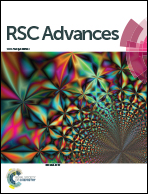An electrochemical sensor based on reduced graphene oxide and copper sulfide hollow nanospheres
Abstract
A nonenzymatic sensor for the detection of hydrogen peroxide (H2O2) was fabricated with reduced graphene oxide (RGO) and copper sulfide hollow nanospheres (CuSHNs). The RGO was obtained by an electrochemical reduction method; and the CuSHNs were acquired using Cu2O nanoparticles as sacrificial templates. The prepared CuSHNs showed a rough hollow ball structure surrounded with a porous shell which supplies many exposed electrocatalytic active sites for the target analyte. The RGO and CuSHNs have good synergistic effects, which can significantly enhance the amperometric response of the sensor toward H2O2. Scanning electron microscopy (SEM), transmission electron microscopy (TEM) and electrochemical measurements were used to characterize the RGO and the CuSHNs. The reduction time of graphene oxide, the pH of PBS and the applied potential were optimized. Under the optimized experimental conditions, a linear range of 0.005 to 4 mM was obtained with a detection limit of 3 μM (S/N = 3). The linear equation is y = 7.1245x + 0.3659 (R = 0.9989). The reproducibility was investigated with an RSD of 2.46% (n = 3). The developed H2O2 sensor based on the RGO and CuSHNs possesses advantages such as simple fabrication, fast response, good selectivity, wide linear range and low detection limit.


 Please wait while we load your content...
Please wait while we load your content...